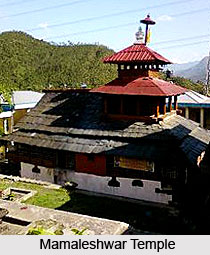 Mamaleshwar Temple is a sacred place of worship, located at Karsog, 13km from Chindi in Mandi district in Himachal Pradesh. The presiding of the shrine is Lord Shiva. Legends speak of the Pandavas, who had built this temple during their period of banishment. The Mamaleshwar Temple is renowned for its enormous carved wooden pillars, inventive woodwork and chiseled stone statues of divinities. The curious attractions of the temple are a single grain of wheat weighing approximately 250gm and a temple drum measuring about 6ft in length. Joginder Nagar Railway Station is the nearest railhead from the Mamaleshwar shrine.
Mamaleshwar Temple is a sacred place of worship, located at Karsog, 13km from Chindi in Mandi district in Himachal Pradesh. The presiding of the shrine is Lord Shiva. Legends speak of the Pandavas, who had built this temple during their period of banishment. The Mamaleshwar Temple is renowned for its enormous carved wooden pillars, inventive woodwork and chiseled stone statues of divinities. The curious attractions of the temple are a single grain of wheat weighing approximately 250gm and a temple drum measuring about 6ft in length. Joginder Nagar Railway Station is the nearest railhead from the Mamaleshwar shrine.
This article is a stub. You can enrich by adding more information to it. Send your Write Up to content@indianetzone.com





















